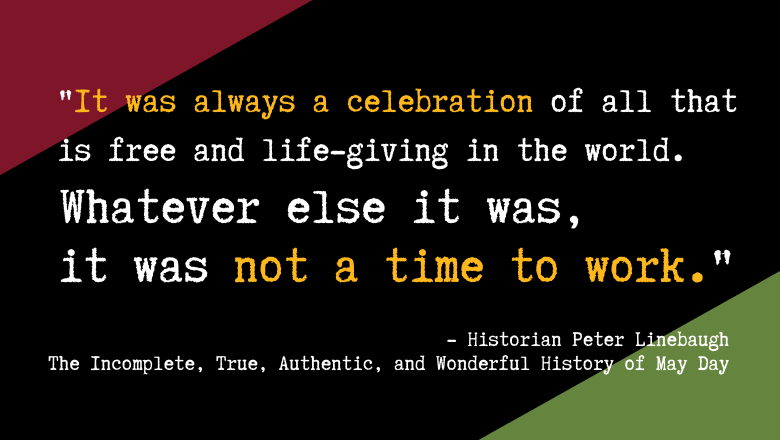
#InternationalWorkersDay honors the immigrant organizers unfairly convicted of conspiracy for participating in a wave of worker protests known as the Great Upheaval throughout the 1800s.
But #MayDay's history reaches back farther, and its demands are yet to be fully met.
1/13
But #MayDay's history reaches back farther, and its demands are yet to be fully met.
1/13

Agricultural workers throughout Europe (pagan peasants) have celebrated #MayDay as a day too holy to work since at least the 4th century; which is when #Beltane, as some called it, was first mentioned in Irish literature.
2/13
2/13

#MayDay was a time workers put away their tools & gathered flowers, danced, feasted, held ceremony, built fires, shared libations, and celebrated community.🌻💃🔥
Because workers weren't grinding away making profits for a boss, many May Day celebrations were criminalized.
3/13
Because workers weren't grinding away making profits for a boss, many May Day celebrations were criminalized.
3/13

Fast forward to #May1st, 1886.
Half a million workers across the U.S. — who had been subjected to 100+ hour work weeks — walked off the job, united in their demand for an 8-hour work day with NO cut in pay.
📢 Half. A. Million.🔥
Bosses were shook.🎩😱
4/13
Half a million workers across the U.S. — who had been subjected to 100+ hour work weeks — walked off the job, united in their demand for an 8-hour work day with NO cut in pay.
📢 Half. A. Million.🔥
Bosses were shook.🎩😱
4/13
Drawing on the long-history of communal resistance associated with #MayDay, workers chose May 1st for this massive protest.
Here's what went down:
💥As early as 1791, carpenters in Philly struck for a shorter day.
Similar actions spread across the country like wildfire.
5/13
Here's what went down:
💥As early as 1791, carpenters in Philly struck for a shorter day.
Similar actions spread across the country like wildfire.
5/13
An international sense of #solidarity was in the air, inspired in part by the French Revolution where workers toppled monarchy rule, won expanded suffrage and a shorter work day.
U.S. workers decided it was their turn to win a battle in the #ClassWar.
6/13
U.S. workers decided it was their turn to win a battle in the #ClassWar.
6/13

1835: Irish coal workers in Philly organized a general strike. Their banners read: From 6 to 6, ten hours work and two hours for meals.
Workers' publications called for an 8-hour day as early as 1836.
As folks kept organizing, workers started to WIN their demands.📢💪🎉
7/13
Workers' publications called for an 8-hour day as early as 1836.
As folks kept organizing, workers started to WIN their demands.📢💪🎉
7/13

1884 ➡️ The Federation of Organized Trades & Labour Unions — a forerunner of the @AFLCIO — holds a convention where workers resolve to take militant collective action for the 8-hour day.
They choose #MayDay, 1886 for the strike and organize like hell for 2 years.📰📢🗣️
8/13
They choose #MayDay, 1886 for the strike and organize like hell for 2 years.📰📢🗣️
8/13
#MayDay was a smashing success across the U.S., and many struck for multiple days.
Chicago was the epicenter, where McCormick company ironworkers led the way. In retribution, company-sponsored police shot & killed four of them.
(#PoliceViolence IS a labor issue.)
9/13
Chicago was the epicenter, where McCormick company ironworkers led the way. In retribution, company-sponsored police shot & killed four of them.
(#PoliceViolence IS a labor issue.)
9/13
To protest the murders at the hands of police, #labor leaders called a mass meeting in #Haymarket Square for May 4.
Thousands attended, and as the meeting wound down, an unknown person threw a stick of dynamite into the crowd. More lives were lost.
10/13
Thousands attended, and as the meeting wound down, an unknown person threw a stick of dynamite into the crowd. More lives were lost.
10/13

8️⃣ labor leaders were— without evidence— tried for the #HaymarketRiot. 4️⃣ were convicted & executed.
State repression didn't end there.
Bosses made sure the trade union movement in city after city was targeted with raids, interrogations, arrests, deportations, & more.
11/13
State repression didn't end there.
Bosses made sure the trade union movement in city after city was targeted with raids, interrogations, arrests, deportations, & more.
11/13
But repression from the 1% couldn't stamp out workers' fire for justice.
Labor rebels, including #LucyParsons, a fierce working-class organizer & widow of #HaymarketMartyr Albert Parsons, rallied people across the U.S. & around the world to keep rising up each #MayDay.
12/13
Labor rebels, including #LucyParsons, a fierce working-class organizer & widow of #HaymarketMartyr Albert Parsons, rallied people across the U.S. & around the world to keep rising up each #MayDay.
12/13

As #nurses celebrate this ancient & enduring peoples' holiday, we continue to fight to protect workers' right to organize; to advance the unfinished struggle for freedom, safety & justice for all.
Shout out to ALL workers organizing to win! #1u
13/13
nationalnursesunited.org/press/maine-me…
Shout out to ALL workers organizing to win! #1u
13/13
nationalnursesunited.org/press/maine-me…
• • •
Missing some Tweet in this thread? You can try to
force a refresh




